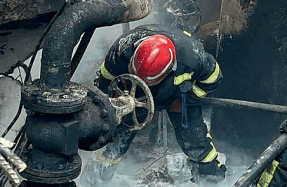

In his 12 years in the frontier service, Bohdan Hotskiy saw manywild places. He thought his home, Ukraine, was the most beautiful country in the world: it had sea and mountains, forests and steppes, marshes and lakes. All was perfect, and so complete that Hotskiy – a 29-year-old captain – never felt the inclination to go abroad. Why bother? “We have everything,” he tells me when we meet in the Ukrainian town of Izmail, close to the border with Romania.
It is high summer. We sit outside on a bench in a central park, not far from the Danube river and Izmail’s port. Hotskiy is dressed in military uniform and holds a Kalashnikov. He is a modest and diffident person, tall and a little awkward. At times he seems reluctant to talk about his recent experiences, giving staccato answers to my questions. His story is remarkable, a tale of survival and dispossession.
Hotskiy tells me that as a teenager he wanted to join an elite service. He became a border guard, rose up the ranks and last year received an order to move to a new maritime location. He was to command a force of 28 men. They were being sent to a strategically important mini-territory 35km from Ukraine’s southern coast. It was a rocky outpost in the Black Sea; an ancient place known in Ukrainian as Ostriv Zmiin yi. English translation: Snake Island.
The island was associated with legends. The Greeks knew it as White Island, after its rock formations, or – as one story had it – the colour of its serpents. It was also associated with warriors. According to mythology, it was where the spirit of Achilles went after his death at Troy. In some versions, Helen of Troy joined him. Sailors were advised not to sleep there, lest they anger the gods.
“When Ukrainian military command lost contact with the island, it assumed all its defenders had been killed
In the modern age, rival powers contested the island: the Ottomans, the Russian empire and the Germans. A lighthouse was built in the 19th century on the spot where a temple to Achilles once stood. There were wrecks from the first and second world wars – a Russian destroyer, sunk in 1917 by a German mine; a Soviet submarine; and a grain ship that had been bound for Europe. Latterly, the island was home to a small population of Ukrainian frontier service staff.
Hotskiy got there just before Christmas. It was a time of new imperial threat.




